OLED (Organic Light Emitting Diodes) are light emitting panels made from organic (carbon based) materials that emit light when electricity is applied. OLED are used today to make beautiful and efficient displays and large, efficient and beautiful lighting panels.
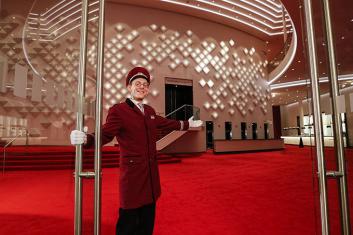
An OLED 'light bulb' is a thin film of material that emits light. OLED is the only technology that can create large "area" lighting panels (as opposed to point or line lighting enabled by LEDs and fluorescent bulbs). OLEDs can be used to make flexible and transparent panels, and can also be color-tunable. OLEDs emit beautiful soft diffused light - in fact OLEDs lighting is the closest light source to natural light (with the exception of the old incandescent lamps).
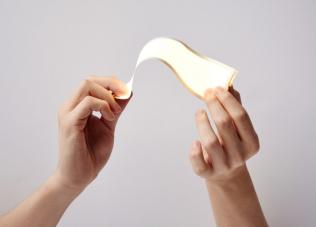
The OLED lighting market
OLED is an amazing technology for lighting - it creates beautiful, efficient and healthy light sources. OLED lighting has great promise but unfortunately the high price of production is a challenge that no one has managed to overcome and OLED lighting remains a small niche industry as of 2021.
In the early years, several large lighting makers (including GE, Philips, OSRAM, LG, Konica Minolta, Panasonic, NEC and others) had active OLED lighting programs, but slowly almost all of these companies dropped out of the market - for various reasons - but the main one being that the large investments in large scale production are not certified to lead to market adoption and the competition with LED lighting is extremely difficult.
There are several companies that still develop and produce OLED lighting panels, but the production volume is still small and most makers target niche markets such as the automotive, health and premium designer markets. Some makers are also offering OLED lamps - click here for our OLED lamp listings.
Further reading
- An introduction to OLEDs
- OLED Technology explained
- Transparent OLEDs
- Flexible OLEDs
- The OLED Handbook, our very own comprehensive guide to OLEDs
OLED lighting introduction and market status
OLED (Organic Light Emitting Diodes) are light emitting panels made from organic (carbon based) materials that emit light when electricity is applied. OLED are used today to make beautiful and efficient displays and large, efficient and beautiful lighting panels.

NTHU starts producing candlelight OLED lighting desk lamps
Excessive exposure to blue light has been linked to many health issues (including cancer, diabetes, heart disease, obesity and insomnia). Researchers from Taiwan's National Tsing-Hua University, led by Prof. J.H. Jou, have been advocates of candle-light OLED lighting for a long time, as part of their fight against the hazards of LEDs and white light. We recently posted on Prof. Jou's latest research on smartphone display risks and the benefits of OLED displays.
In 2015, Taiwan's PMOLED maker WiseChip Semiconductors licensed National Tsing-Hua University's blue-light free OLED lighting technology (called Candlelight OLEDs), with an aim to mass produce these OLEDs by the end of 2017. That project faced delays, however and now NTHU announced that following a collaboration with China's OLED lighting maker First-o-lite it is now ready to commercialize its technology and NTHU demonstrated the first device to use these new panels - the OLED lighting desk-lamp you can see in the video above (and photo below).
Mercedes to use OLED taillights in its new C238 E-Class Coupe
In 2017, Mercedes introduced OLED Taillight in its Mercedes 2018 S-Class Coupe and Convertible cars, and it seems that the German auto maker is now aiming to use OLED taillights in another model - the upcoming C238 E-Class Coupe was spotted in Stuttgart - with a new OLED taillight design.
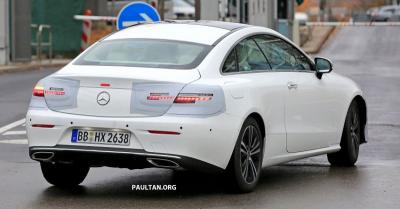
The 2018 S-Class Coupe and Convertible used OLEDs produced by LG Display, and each taillight module contains 33 individually controlled red OLED panels. In the new C238 E-Class Coupe, it seems that each module uses 16 red OLEDs.
Yeolight new candle-like OLED lighting panels to soon hit the market
Yeolight Technology (which was spun-off Visionox in May 2015) developed candle-shaped transparent OLED lighting panels. The segmented panels have five different lighting panels each with its own brightness. The total size is 11.26 x 26.26 mm (with a thickness of 1.05 mm).
Yeolight tells us that these new OLED candles has been developed for a customer that will soon ship its final product to the market. The panels are now in production.
Lyteus partners demonstrate the world's longest flexible OLED lighting device at 15 meters
The Fraunhofer FEP institute, the Holst Center and other partners have developed a 15-meter long OLED lighting panel, the longer OLED device ever (beating their own 2017 record of a 10-meter OLED). This work was done as part of the Lyteus, the EU's â¬14 million initiative within PI-SCALE.
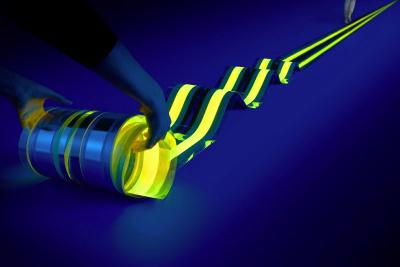
The partners in this project say that this is the first OLED produced using a new unique roll-to-roll (R2R) process that combines the performance of an evaporated OLED stack with solution processing of auxiliary layers.
OLEDWorks flexible OLED lighting panels, now branded as Wave, are now commercially available
In March 2018 OLEDWorks launched its first flexible OLED panels, branded as BendOLEDs. The company now announced that the panels are now commercially available - and rebranded as LumiCurve Wave, which is the first panel in OLEDWorks LumiCurve product family.
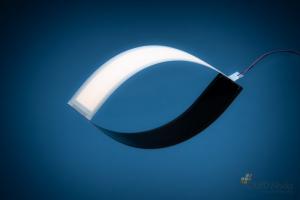
The LumiCurve Wave is produced on Corning's 0.1mm thin Willow Glass flexible glass substrate. OLEDWorks says that the Wave panels are extremely thin and light and deliver the superb light quality and excellent color rendering that is uniquely achievable with OLED.
An Audi ad at Departures magazine includes flexible OLED lighting panels
Departures magazine (a premium magazine shipped to around 25,000 American Express Platinum Card members) included an innovative ad for Audi's A8 with flexible OLED lighting panels that are activated when first opened (and also when the reader clicks on a replica Audi key that is included with the magazine).
Personally this seems to be an overly expensive and wasteful way to advertise. We do not know what kind of OLED panels are used in the ads (which was produced by US-based Structural Graphics). In 2017 Konica Minolta Pioneer OLED (KMPO) demonstrated its simple flexible OLED lighting panels integrated into packaging technology - which could be the one adopted here (although other companies have demonstrated similar solutions as well).
Cynora extends its cooperation with LGD for deep-blue TADF emitters, samples green TADF emitters
TADF developer CYNORA has announced that it has extended its joint-development agreement with LG Display. The two companies have been co-developing deep-blue TADF OLED emitters for two years, and have now decided to continue the cooperation towards the commercialization of TADF emitters in OLED displays.

CYNORA's latest deep-blue material specification was presented in May 2018 - with a CIEy of 0.14, EQE of 20% and a lifetime of 20 hours LT97 at 700 nits. Cynora expects to have blue material in mass production by 2020. Cynora says that its TADF materials are suitable for both self-emitting or co-emitting approaches (which includes hyper-fluorescence).
Yonsei University deploys OLED lighting installations
Korea's Yonsei University deployed OLED lighting installations, one in its 24-hour study room (Laptop area) and the other in its Hall of Fame. The University says that the new OLED lighting systems provide better eye-comfort and upgrade the study atmosphere.
The Laptop Area uses rectangular OLED panels, both in the ceiling chandeliers and on the desks themselves. The Hall of Fame uses LGD's 300x300 mm flexible OLED panels.
The EU-funded Flexolighting project believes that OLED lighting cost can be reduced to 1 Euro per 100 lumens
In 2015, the EU launched the â¬4.4 million Flexolighting project (led by Brunel University London) with an aim to develop new materials, processes and methods to overcome current OLED lighting challenges - including lifetime, lighting uniformity and more.
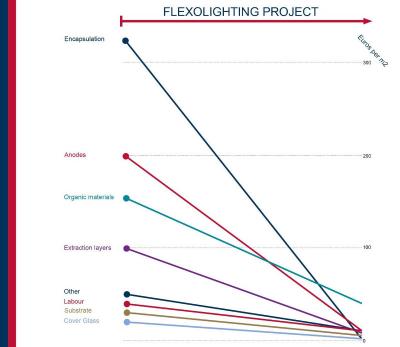
The project's consortium announced that following the project completion and a rethinking of the complete OLED supply chain, it believes that high efficiency OLED lighting panels can be produced at a cost that is on a similar level with LED lighting.
Pagination
- Previous page
- Page 9
- Next page



